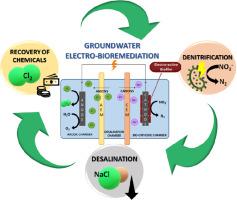Water Research ( IF 12.8 ) Pub Date : 2021-10-05 , DOI: 10.1016/j.watres.2021.117736 Giulia Puggioni 1 , Stefano Milia 2 , Emma Dessì 3 , Valentina Unali 2 , Narcís Pous 4 , M Dolors Balaguer 4 , Sebastià Puig 4 , Alessandra Carucci 5

|
Groundwater pollution and salinization have increased steadily over the years. As the balance between water demand and availability has reached a critical level in many world regions, a sustainable approach for the management (including recovery) of saline water resources has become essential. A 3-compartment cell configuration was tested for a new application based on the simultaneous denitrification and desalination of nitrate-contaminated saline groundwater and the recovery of value-added chemicals. The cells were initially operated in potentiostatic mode to promote autotrophic denitrification at the bio-cathode, and then switched to galvanostatic mode to improve the desalination of groundwater in the central compartment. The average nitrate removal rate achieved was 39±1 mgNO3−-N L−1 d−1, and no intermediates (i.e., nitrite and nitrous oxide) were observed in the effluent. Groundwater salinity was considerably reduced (average chloride removal was 63±5%). Within a circular economy approach, part of the removed chloride was recovered in the anodic compartment and converted into chlorine, which reached a concentration of 26.8±3.4 mgCl2 L−1. The accumulated chlorine represents a value-added product, which could also be dosed for disinfection in water treatment plants. With this cell configuration, WHO and European legislation threshold limits for nitrate (11.3 mgNO3−-N L−1) and salinity (2.5 mS cm−1) in drinking water were met, with low specific power consumptions (0.13±0.01 kWh g−1NO3−-Nremoved). These results are promising and pave the ground for successfully developing a sustainable technology to tackle an urgent environmental issue.
中文翻译:

含盐地下水中硝酸盐的电生物修复与伴随产氯相结合
多年来,地下水污染和盐渍化稳步增加。由于世界许多地区的水资源需求和可用性之间的平衡已达到临界水平,因此必须采用可持续的方法来管理(包括恢复)咸水资源。基于同时脱氮和脱盐受硝酸盐污染的咸水地下水和回收增值化学品的新应用,测试了 3 室电池配置。细胞最初以恒电位模式运行以促进生物阴极的自养反硝化,然后切换到恒电流模式以改善中央隔室的地下水脱盐。实现的平均硝酸盐去除率为39±1 mgNO 3 - -NL-1 d -1,并且在流出物中没有观察到中间体(即,亚硝酸盐和一氧化二氮)。地下水盐度显着降低(平均氯化物去除率为 63±5%)。在循环经济方法中,部分去除的氯化物在阳极室中被回收并转化为氯气,其浓度达到26.8±3.4 mgCl 2 L -1。积聚的氯代表一种增值产品,也可用于水处理厂的消毒。与此小区配置,WHO和硝酸(11.3 mgNO欧洲立法的阈值极限3 - -NL -1)和盐度(为2.5mS cm的-1) 在饮用水中得到满足,比功率消耗低(0.13±0.01 kWh g -1 NO 3 - -N去除)。这些结果很有希望,并为成功开发可持续技术以解决紧迫的环境问题奠定了基础。



























 京公网安备 11010802027423号
京公网安备 11010802027423号